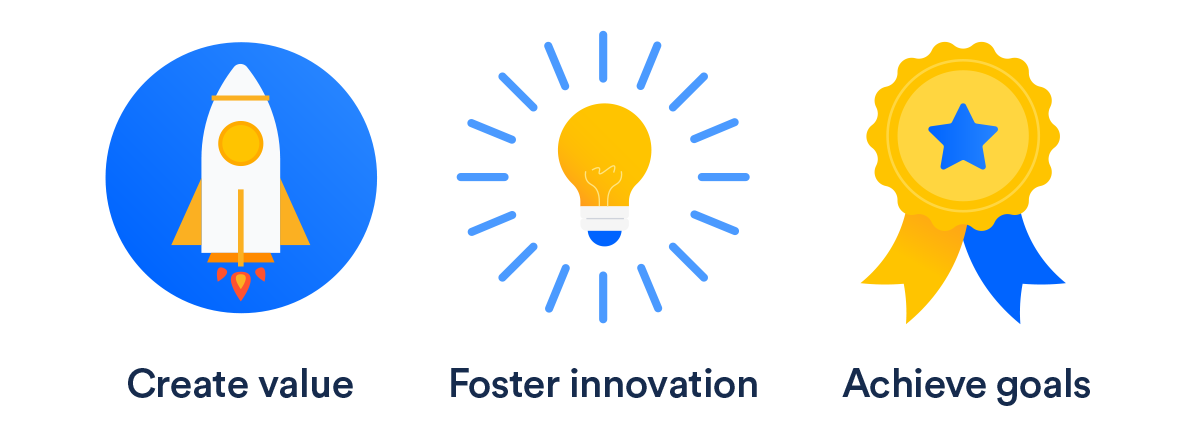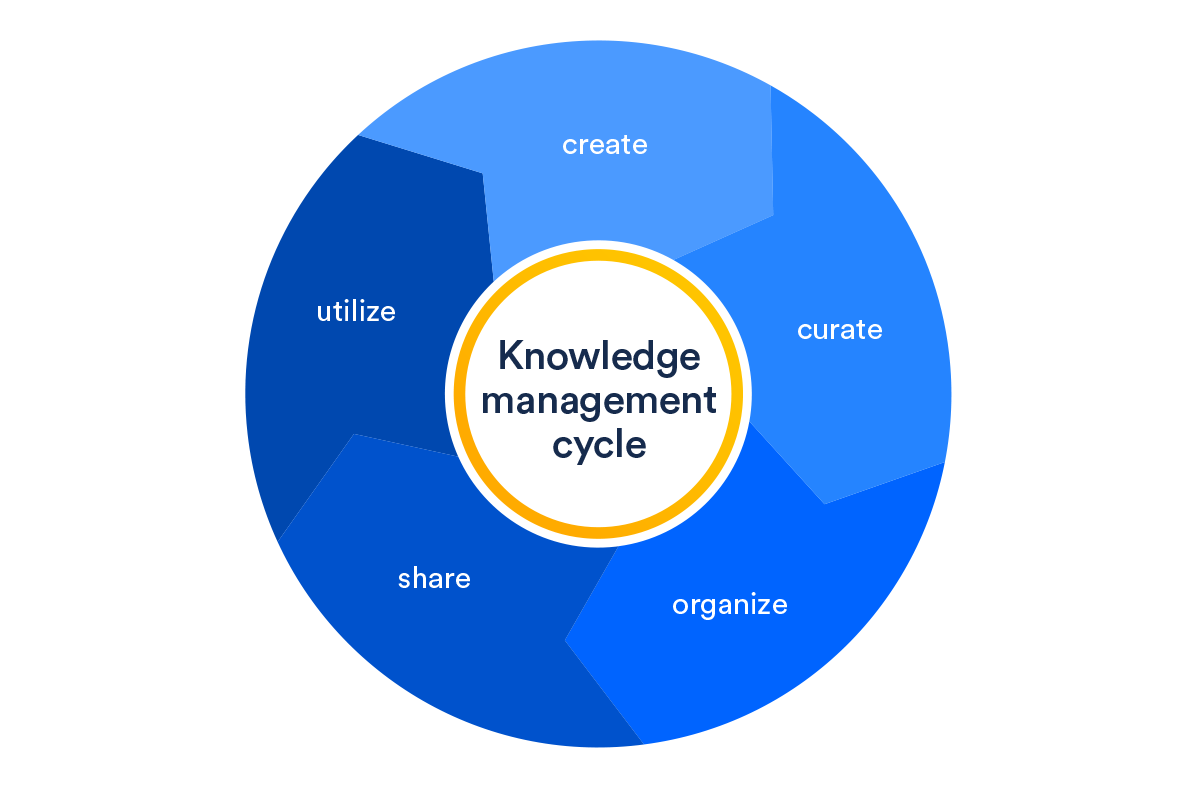¿Qué es el soporte de TI?
Gestión de conocimientos: definición y ventajas
La gestión de conocimientos es el proceso de crear, seleccionar, compartir, utilizar y gestionar los conocimientos de toda una organización e incluso de distintos sectores.
En ITIL 4 se explica que "la gestión de conocimientos pretende garantizar que las partes interesadas obtengan la información correcta, en el formato adecuado, en el nivel correspondiente y en el momento indicado de acuerdo con su nivel de acceso y otras políticas relevantes. Esto requiere un procedimiento de adquisición de los conocimientos, lo que incluye el desarrollo, la captura y la recopilación de los conocimientos no estructurados, ya sean formales y documentados o informales y tácitos". (ITIL 4, 5.1.4, Gestión del conocimiento).
Las bases de conocimientos son el pilar básico de la gestión de conocimientos. En TI, son bibliotecas de autoservicio en línea con información sobre un producto, servicio, departamento o tema. Los datos pueden proceder de cualquier parte, aunque normalmente provienen de distintos colaboradores que conocen bien el tema en cuestión. Las bases de conocimientos pueden incluir preguntas frecuentes, guías de solución de problemas y cualquier otro detalle que quieras o necesites conocer.
Todos hemos dependido alguna vez de los motores de búsqueda, porque facilitan mucho la gestión de conocimientos. Estos motores aprovechan una amplia base de conocimientos conectada internacionalmente, lo que también se conoce como Internet. Solo tienes que introducir un tema y obtienes la información que necesitas. Para los equipos de TI, la gestión de conocimientos puede ser una tarea compleja, aunque la recompensa vale la pena.
Ventajas de la gestión de conocimientos
Los servicios cada vez son más complejos, así que ahora los equipos de TI tienen que mantenerse al día con la amplia gama de tecnologías y procedimientos necesarios para dar un soporte eficaz a los clientes. Por eso la gestión de conocimientos es más importante que nunca. Una buena gestión de conocimientos aglutina el conocimiento de todas las personas de la organización y permite compartirlo fácilmente. Además, no se pierde ninguna información cuando alguien se va de vacaciones, se pone enfermo o deja la empresa.
Desde un punto de vista global, esto permite:

- Aporta valor: proporciona la información adecuada a las personas indicadas en el momento oportuno.
- Fomenta la innovación: aprovecha el intercambio de conocimientos en las lluvias de ideas, la colaboración y la búsqueda de grandes ideas.
- Alcanza las metas: ayuda a los equipos a establecer metas y a alcanzarlas.
La gestión de conocimientos pone el contenido al alcance de la mano de las personas que desarrollan y proporcionan los productos y servicios, tanto en las organizaciones grandes como en las pequeñas. Esto, que por sí solo ya es un beneficio, también ayuda a acortar los ciclos de desarrollo de nuevas iniciativas, aumenta la conexión entre el personal interno y externo, permite una gestión más eficaz de los entornos empresariales, y aprovecha los activos y el capital intelectual de la plantilla.
Tipos de gestión del conocimiento
La gestión de conocimientos es un ciclo constante de transformación de los conocimientos tácitos o implícitos en conocimientos explícitos. Parece complicado, ¿verdad? Pues vamos a retroceder un poco para conocer los tres tipos de conocimiento que existen.
- Conocimiento tácito: es el que proviene del contexto, la práctica o la experiencia personal. Permanece en la mente de las personas, así que es difícil de transmitir a los demás. El conocimiento tácito se basa en la experiencia y la intuición (por ejemplo, hablar otro idioma), por lo que es una gran ventaja competitiva y, a la vez, un gran reto a la hora de implementar sistemas de gestión de conocimientos.
- Conocimiento explícito: está codificado; es decir, se ha documentado y está fácilmente accesible. Dada su naturaleza sencilla, el conocimiento explícito es mucho más fácil de almacenar y consultar en un sistema de gestión de conocimientos. El reto que presenta es asegurarse de que se revisa y se actualiza.
- Conocimiento implícito: está integrado en los procesos, las rutinas o la cultura de la organización. Puede tener un formato formalizado, como un manual o pautas escritas, pero el conocimiento en sí no es explícito, sino que reside en la forma en que funciona una organización.
Conocer estos tres tipos de conocimiento es un buen punto de partida para entender cómo se debe gestionar el conocimiento en tu empresa. Si se hace bien, puede contribuir a aportar valor, fomentar la innovación y conseguir los objetivos.
Prácticas recomendadas para la gestión de conocimientos
El conocimiento es uno de los activos más valiosos de las organizaciones de TI, y su intercambio abierto puede ayudar al equipo a estar en sintonía, colaborar y tomar mejores decisiones de forma más rápida. El conocimiento es aún más poderoso cuando se intercambia abiertamente y deja de ser de una sola persona para pasar a toda la comunidad. Estas son algunas prácticas recomendadas para fomentar un intercambio más abierto:
- Reúne los conocimientos de tu equipo en un solo repositorio o sistema. A medida que la tecnología del lugar de trabajo evoluciona, el conocimiento se dispersa y reside en distintos lugares, como el correo electrónico, los tickets y la mente de los miembros individuales del equipo. Elegir la tecnología adecuada es importante, pero esto solo es un paso más en tu estrategia global de gestión de conocimientos.
- Aumenta la transparencia con información abierta y compartida. En lugar de tener los documentos en correos electrónicos y carpetas sueltos o bloqueados por la configuración de permisos, invierte en tecnología que conecte y unifique todos los conocimientos. Los conocimientos de la organización deben ser fáciles de consultar, encontrar y crear. Anima al equipo a colaborar y a editar páginas, insertar comentarios o mencionar a compañeros para que hagan revisiones por pares.
- Da visibilidad al trabajo con un cartel de proyecto. En cada iniciativa importante, crea un cartel de proyecto para que todo el equipo y las partes interesadas estén al día de los objetivos y progresos. Este es un documento vivo y accesible que puede ayudarte a establecer la conceptualización del problema, definir el alcance y obtener comentarios.
- Apuesta por artículos o respuestas breves. Compartir documentación no siempre significa compartir conocimientos. Por eso es mejor adaptar el contenido al equipo en lugar de crear documentos largos y extensos. Siempre es más rápido aprender y asimilar la información cuando no se tarda mucho en leerla, es fácil de entender y se publica en el momento justo.
- Respalda una cultura de intercambio de conocimientos. Recompensa a las personas que más contribuyen con un programa de reconocimiento que valore tanto la calidad como la cantidad. Para servir de ejemplo positivo, tu equipo directivo puede añadir periódicamente información, como novedades importantes de la organización. También puede usar tu herramienta para interactuar directamente con los equipos y animarlos a hacer lo mismo.
Cómo crear una estrategia de gestión de conocimientos
La gestión de conocimientos es una responsabilidad que nunca termina. Incluso después de implementar un sistema, hay que ir añadiendo materiales nuevos y eliminando los obsoletos, y también se descubre conocimiento oculto.

Estos son los pasos clave para crear una buena estrategia de gestión de conocimientos para tu organización.
1. Determina la situación de la empresa y desarrolla objetivos y metas.
Al realizar primero un análisis interno de tu organización, podrás alinear el sistema de gestión de conocimientos con tus objetivos.
2. Prepara la organización para la implementación.
Sé consciente de que tienes una tarea importante entre manos y de que van a hacer falta cambios culturales.
3. Forma un equipo de gestión de conocimientos.
Puede parecer evidente, pero te sorprendería la cantidad de veces que las organizaciones olvidan esto. El primer paso para implementar cualquier nuevo proceso es poner a alguien al mando.
4. Haz una auditoría de los conocimientos.
Averigua qué conocimientos están escondidos y dónde. Piensa qué falta y empieza a prepararlo todo para lo que quieres hacer. En lo que respecta al conocimiento tácito, este proceso requiere observación, entrevistas o encuestas a los expertos.
5. Determina las necesidades tecnológicas y dales prioridad.
Averigua qué herramientas necesitarás para implementar la gestión de conocimientos. Planifica los costes ya para que sea más fácil asumirlos más adelante.
6. Determina los atributos y funciones clave del sistema de gestión de conocimientos.
Piensa en el diseño que quieres que tenga el sistema. Luego, haz una lista. Asegúrate de que a nivel interno todo encaja, y de que con la tecnología y el alcance escogidos conseguirás los resultados que necesitas y que las partes interesadas estén satisfechas. Si no sabes qué buscar, en la siguiente sección encontrarás algunas ideas.
7. Organiza todo el conocimiento en un solo lugar.
Tienes una gran cantidad de conocimiento, pero está repartido por todas partes. Reúnelo todo en un repositorio único fácil de usar y de acceder de algún proveedor de soluciones. Esto hará que sea mucho más sencillo para la organización aprender y atender a los clientes, y facilitará mucho la vida a todas las partes implicadas.
8. Mide y mejora tu programa.
Una vez que hayas lanzado tu práctica de gestión de conocimientos, revísala. Analiza qué está yendo bien y qué no. Haz los ajustes necesarios y actualízalo constantemente. Este es un proceso continuo.
Cómo escoger un sistema de gestión de conocimientos
Un gran software simplifica mucho la gestión de conocimientos. Por eso, hazte estas preguntas sobre tu tecnología antes de pasar a la implementación:
- ¿Promueve y fomenta la colaboración y la comunicación?
- ¿La gente puede etiquetar, compartir y organizar el contenido?
- ¿Se puede personalizar y añadirle funciones?
- ¿Es lo suficientemente flexible como para adaptarse a los cambios?
- ¿La migración se hace sin problemas?
- ¿Es escalable en una organización en crecimiento?
- ¿Hasta qué punto protegerá el sistema?
- ¿Permite hacer mediciones?
- ¿Facilita la navegación?
- ¿El motor de búsqueda es potente?
- ¿Puede segmentar la información en diferentes proyectos, temas, etc.?
- ¿Puede integrarse con el software que ya tienes?
- ¿Permite los permisos flexibles?
- ¿Incluye elementos típicos de las redes sociales como "Me gusta" y comentarios?
Aparte de la funcionalidad, lo más importante es asegurarse de que el sistema de gestión de conocimientos esté basado en las necesidades y ayude a generar ideas e innovaciones, fomentar una cultura y comunidad de intercambio de conocimientos, descubrir y crear conocimientos especializados, y promover los comentarios.
Resumen
Todo el mundo puede beneficiarse de la gestión de conocimientos. Independientemente del negocio o mercado, en una organización siempre hay conocimientos que vale la pena compartir. Y esto es así en todos los departamentos: TI, atención al cliente, recursos humanos, el equipo jurídico e incluso marketing o finanzas, todos tienen conocimientos que constantemente comparten con un equipo o con la organización entera. Si dispones de un plan, los trabajadores de todos los departamentos y disciplinas podrán acceder a la base de conocimientos de la empresa para resolver los problemas y evitarlos en el futuro.
Gestiona mejor el conocimiento con Jira Service Management.
Atlassian para ITSM
Conceptos básicos que necesitas saber acerca de ITSM con Atlassian: entrega, operaciones y soporte de TI, además de prácticas recomendadas y consejos.
Obtener la guíaGuía de la base de conocimientos: ejemplos, plantillas y prácticas recomendadas
Descubre las ventajas de disponer de una base de conocimientos para tu empresa. Aumenta la productividad, mejora el servicio de atención al cliente y optimiza la gestión de la información de forma eficaz.
Leer el artículo